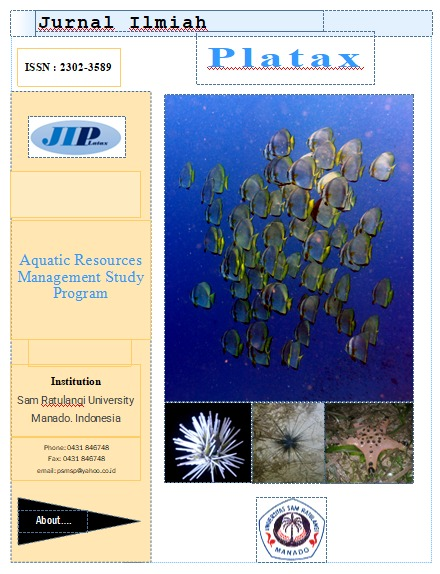Seagrass Community in the Coastal Waters of Sapa Village, Tenga District, South Minahasa Regency, North Sulawesi Province
DOI:
https://doi.org/10.35800/jip.v11i2.48258Keywords:
Seagrass;, Sapa village;, community structure;Abstract
Sapa Village, Tenga District, South Minahasa Regency, North Sulawesi Province has a seagrass meadow ecosystem, but there is still a lack of information about the seagrass community in the waters of Sapa Village, which is the reason for researching the presence of seagrass in these waters. With the aim of knowing the types of seagrass, environmental conditions, species density, relative density, domination index, and species diversity index. Based on the results of observations at the location, it showed a temperature of 30OC, salinity of 30‰, pH 8, and sandy substrate and coral rubble. The results of the identification there are 4 types of seagrass namely Thalassia hemprichii, Syringodium isoetifolium, Cymodocea rotundata, and Halodule uninervis. The type with the highest number of individuals vizThalassia hemprichii with a total of 694 individuals, Halodule uninervis 557 individuals, Cymodocea rotundata358 individuals andSyringodium isoetifolium 324 individuals. Density index type (10,80 – 23,13 individuals/m2), relative density (16.76 - 35.90%) dominance index D = 0.32, and diversity H = 1.33.
Keywords: seagrass, sapa village, community structure
Abstrak
Desa Sapa Kecamatan Tenga Kabupaten Minahasa Selatan Provinsi Sulawesi Utara memiliki ekosistem padang lamun namun masih kurangnya informasi mengenai komunitas lamun di perairan Desa Sapa ini menjadi alasan untuk meneliti tentang keberadaan lamun di perairan tersebut. Dengan tujuan untuk mengetahui jenis-jenis lamun, kondisi lingkungan, Kepadatan spesies, Kepadatan Relatif, Indeks Dominasi, dan Indeks Keanekaragaman Spesies. Berdasarkan hasil pengamatan di lokasi menunjukan suhu 30oC, salinitas 30‰, pH 8 dan substrat berpasir serta pecahan karang. Hasil identifikasi terdapat 4 jenis lamun yaitu Thalassia hemprichii, Syringodium isoetifolium, Cymodocea rotundata, dan Halodule uninervis. Jenis dengan jumlah individu terbanyak yaitu Thalassia hemprichii dengan jumlah 694 individu, Halodule uninervis 557 individu, Cymodocea rotundata 358 individu dan Syringodium isoetifolium 324 individu. Indeks kepadatan jenis (10,80 – 23,13 individu/m2), kepadatan relatif (16,76 - 35,90%) indeks dominasi D=0,32 dan keanekaragaman H= 1,33.
Kata kunci: lamun, desa sapa, struktur komunitas
References
Bengen DG. 2002. Pedoman Teknis Pengenalan dan pengelolaan Ekosistem Mangrove. Pusat Kajian Sumberdaya Pesisir dan Lautan. Institut Pertanian Bogor (PKSPL-IPB).
Dahuri, R. 2003. Keanekaragaman Hayati Laut Aset Pembangunan Berkelanjutan Indonesia. Penerbitan Gramedia Pustaka Utama. Jakarta
Dahuri, R., Rais Y., Putra S.,G., Sitepu, M.J., .2001.’’Pengelolaan Sumber Daya Wilayah Pesisir dan Lautan Secara Terpadu.’’Jakarta: PT. Pradaya Paramita
Dwintasari,F.,2009. Hubungan Ekologis Lamun (Seagrass) Terhadap Kelimpahan dan keanekaragaman Ikan di Pulau Pramuka Kepulauan Seribu. [Skripsi]. Institut Pertanian Bogor
Effendi, H. 2003. Telaah Kualitas Air Bagi Pengelolaan Sumberdaya dan Lingkungan Perairan. Penerbit ; Kanisius, Yogyakarta
Friedhelm. 2012. Ecology of Insular Southeast Asia. Diterjemahkan dan diterbitkan oleh Salemba teknika : Jakarta.
Krebs,C,J.1999. Ecological Methodology. Second Edition. Addison Wesley Longman, Inc. New York.
Odum, E. P. 1998.Dasar-Dasar Ekologi Edisi Ketiga. Universitas Gajah Mada Press. Yogyakarta
Rahmawati, S., Irawan, A., Supriyadi I. H., & Azkab M. H. 2017. Panduan Pemantauan Penilaian Kondisi Padang Lamun. Edisi 2. Jakarta: COREMAP CTI LIPI. vi + 35 hlm
Sjafrie, N.D.M., 2018. Potensi Energi Lamun Untuk Mendukung Pelestarian Dugong (Dugong Dugon) Di Desa Berakit Dan Desa Pengudang Pulau Bintan. Widyariset, 4(2), pp.113-122.
Tupan, C. I., Herawati, E. Y., & Arfiati, D. (2014). Profile of lead (Pb) heavy metal in water, sediment and seagrass (Thalassia hemprichii) in Ambon Island, Maluku, Indonesia. Journal of Biodiversity and Environmental Sciences (JBES), 5(4), 65-73.
Downloads
Published
How to Cite
Issue
Section
License
Copyright (c) 2023 Melinda Runturambi, Febry S. I. Menajang, Khristin I.F. Kondoy, Unstain N. W. J. Rembet, Fransine B. Manginsela, Alex D. Kambey

This work is licensed under a Creative Commons Attribution-NonCommercial 4.0 International License.
COPYRIGHT
Authors who publish with this journal agree to the following terms:
Authors hold their copyright and grant this journal the privilege of first publication, with the work simultaneously licensed under a Creative Commons Attribution License that permits others to impart the work with an acknowledgment of the work's origin and initial publication by this journal.
Authors can enter into separate or additional contractual arrangements for the non-exclusive distribution of the journal's published version of the work (for example, post it to an institutional repository or publish it in a book), with an acknowledgment of its underlying publication in this journal.
Authors are permitted and encouraged to post their work online (for example, in institutional repositories or on their website) as it can lead to productive exchanges, as well as earlier and greater citation of the published work (See The Effect of Open Access).




















